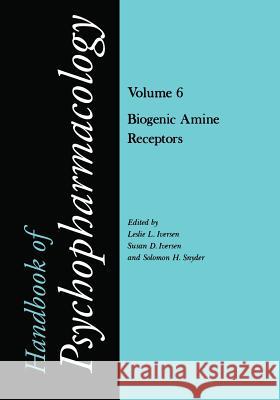Biogenic Amine Receptors » książka



Biogenic Amine Receptors
ISBN-13: 9781468485165 / Angielski / Miękka / 2012 / 307 str.
Biogenic Amine Receptors
ISBN-13: 9781468485165 / Angielski / Miękka / 2012 / 307 str.
(netto: 191,66 VAT: 5%)
Najniższa cena z 30 dni: 192,74
ok. 22 dni roboczych
Dostawa w 2026 r.
Darmowa dostawa!
1 Amine Receptors in CNS. I. Norepinephrine.- 1. Introduction.- 2. Localizing Norepinephrine-Containing Synapses.- 3. Effects of Norepinephrine on Central Neurons.- 3.1. Overview of Microiontophoretic Studies.- 3.2. Identification of Test Neurons.- 4. Action of Norepinephrine on Defined Postsynaptic Neurons.- 4.1. The Noradrenergic Projection to Rat Cerebellar Purkinje Cells.- 4.2. Characterization of the Purkinje Cell Adrenergic Receptor.- 4.3. Activation of the Adrenergic Pathway.- 5. The Noradrenergic Projection to Rat Hippocampal Pyramidal Cells and Other Brain Stem Areas.- 6. Cyclic 3?,5?-Adenosine Monophosphate as a Mediator of Norepinephrine Action in the Central Nervous System.- 6.1. Interpreting the “Failures to Confirm” Neuronal Depression by Cyclic AMP.- 6.2. Actions of Calcium.- 7. Conclusions.- 8. References.- 2 Amine Receptors in CNS. II. Dopamine.- 1. Introduction.- 2. Localization and Function of Dopamine.- 2.1. Cerebral Cortex.- 2.2. Retina.- 2.3. Hypothalamus.- 2.4. Basal Ganglia.- 3. Synthesis and Degradation of Striatal Dopamine.- 4. Stimulus-Evoked Release of Dopamine in Striatum.- 5. Dopamine Receptor Activation: Effects of Dopamine on Striatal Neurons.- 6. Pharmacological Characterization of Presumed Dopaminergic Neurons.- 7. Presynaptic vs. Postsynaptic Dopamine Receptors.- 8. Behavioral Studies.- 8.1. Turning Behavior.- 8.2. Stereotyped Behavior.- 8.3. Compulsive Gnawing Syndrome.- 9. Structural Conformations.- 9.1. Dopamine.- 9.2. Dopamine Agonists.- 9.3. Dopamine Antagonists.- 10. Dopamine Receptor: Adenylate Cyclase.- 11. Conclusion.- 12. References.- 3 Amine Receptors in CNS. III. 5-Hydroxytryptamine in Brain.- 1. Introduction.- 2. Experimental Studies on 5-HT Receptors.- 2.1. Physiological Effects of 5-HT on Brain Neurons.- 2.2. Studies on Putative 5-HT Agonists and Antagonists in Brain.- 2.3. Studies on in Vitro Binding of 5-HT and LSD: Possible Relationship to 5-HT Receptors.- 3. Conclusions.- 4. References.- 4 Acetylcholine Receptors in Vertebrate CNS.- 1. Introduction.- 2. In Vivo Effects of ACh and Agonists on CNS.- 2.1. Gross Applications and Recording.- 2.2. Effects of Microapplications.- 2.3. Distribution of Different Kinds of ACh Receptors.- 2.4. ACh Receptors on Other Tissue Components.- 3. In Vitro Effects of ACh and Agonists on CNS.- 3.1. ACh Responses of Neuroblastoma Cells.- 3.2. Isolation of Central ACh Receptors.- 3.3. Role of Guanosine Derivatives in ACh Response.- 4. Significance of ACh Receptors.- 5. Evidence for Central Cholinergic Neurotransmission and Its Functional Significance.- 5.1. Fast Excitation.- 5.2. Slow Excitation.- 5.3. Inhibition.- 6. References.- 5 Receptor Feedback and Dopamine Turnover in CNS.- 1. Introduction.- 1.1. Brain Dopamine.- 1.2. Dopamine Receptors.- 2. Dopamine as a Transmitter Substance in CNS.- 2.1. Chemical Identification.- 2.2. Distribution of Dopamine Neurons.- 3. T ransmitter Metabolism in Brain Dopamine Neurons.- 3.1. Synthesis.- 3.2. Dopamine Metabolism.- 3.3. Dopamine Turnover.- 4. Effect of Dopamine Receptor Blocking Drugs on Transmitter Turnover.- 4.1. Neuroleptics.- 4.2. Chlorpromazine Metabolites.- 5. Effect of Dopamine Receptor Stimulating Drugs on Transmitter Turnover.- 5.1. Apomorphine and Related Compounds.- 5.2. Piribedil.- 6. Relation Between Drug Effects on Dopamine Turnover Regulation in Vivo and Dopamine-Stimulated Adenylate Cyclase Activity in Vitro.- 7. Evidence for Receptor-Mediated Control of Brain Dopamine Turnover in Man.- 8. References.- 6 Basic Mechanisms and Local Feedback Control of Secretion of Adrenergic and Cholinergic Neurotransmitters.- 1. Introduction.- 2. Secretion of Adrenergic and Cholinergic Neurotransmitters.- 2.1. Basic Mechanisms.- 2.2. Conflicting Current Concepts of Basic Mechanisms in Neurotransmitter Secretion.- 2.3. Circumstantial Evidence Against a Quantum Size of 15,000 or More Transmitter Molecules.- 2.4. Validity of the Electrophysiological Method for Measuring Neurotransmitter Secretion.- 2.5. Fractional Secretion from Vesicles?.- 2.6. Conclusions.- 3. Local Feedback Control of Secretion of Adrenergic and Cholinergic Neurotransmitters.- 3.1. Definition.- 3.2. Immediate Historical Background.- 3.3. Facilitation of Neurotransmitter Secretion on Repetitive Stimulation.- 3.4. Depression of Neurotransmitter Secretion on Repetitive Stimulation.- 3.5. Dual Negative-Feedback Control of Probability for Quantal Secretion of NE from Sympathetic Nerves.- 3.6. Levels and Mechanisms Involved in Feedback Control.- 3.7. Conclusions.- 4. References.- 7 The Cholinergic Receptor Protein from Fish Electric Organ.- 1. Introduction.- 2. A Model for the Electrogenic Action of Acetylcholine.- 3. Anatomy of the Electric Organs and of the Electroplaques.- 4. The Electric Discharge and the Electrophysiology of the Electroplaques.- 5. Pharmacology of the Isolated Electroplaque from Electrophorus.- 5.1. Response of the Isolated Electroplaque to Bath-Applied Agonists.- 5.2. Concentration-Effect Curves: Effects of Agonists, Antagonists, and Local Anesthetics.- 5.3. Effects of -SH and S—S Reagents on Response to Agonists.- 5.4. Affinity Labeling of the Receptor Site.- 5.5. Distinction Between the Catalytic Site of Acetylcholinesterase and the Cholinergic Receptor Site.- 5.6. Snake Venom ?-Toxins as Specific Reagents of the Nicotinic Receptor Site.- 6. Localization of the Cholinergic Receptor Site in Electrophorus Electroplaque.- 7. Subcellular Fractionation of the Electric Organ.- 8. Permeability Response of Isolated Microsacs to Cholinergic Agonists.- 9. Characterization of the Cholinergic Receptor Site on Excitable Microsacs.- 10. Solubilization and Purification of the Cholinergic Receptor Protein.- 11. Chemical Properties of the Purified Receptor Protein.- 12. Physical Properties of the Cholinergic Receptor Protein.- 13. Binding Properties of the Purified Protein.- 13.1. Electrophorus.- 13.2. Torpedo.- 14. Immunological Characterization of the Cholinergic Receptor Protein from Electrophorus.- 15. Conformational Transitions of the Receptor Protein Associated with Its Physiological Function.- 16. Turnover Number of the Cholinergic Ionophore.- 17. Reconstruction of a Chemically Excitable Membrane.- 18. Conclusion.- 19. References.
1997-2025 DolnySlask.com Agencja Internetowa
KrainaKsiazek.PL - Księgarnia Internetowa









